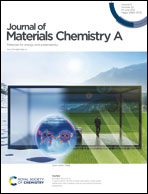Enhanced oxidation of sulfite over a highly efficient biochar-induced silica composite for sulfur resource utilization in magnesia desulfurization†
Abstract
Magnesia-based desulfurization is a novel sulfur recovery FGD technique, whose by-product sulfite can be oxidized into resource available sulfate thus achieving appreciable economic benefits as a fertilizer. Biochar is a pyrogenic carbonaceous material, which possesses abundant surface functional groups and exhibits strong responsiveness to chemical redox. To accelerate sulfite oxidation, a biochar-induced silica composite (BISC) is synthesized by using maple-derived biochar. In this study, the induction of maple-derived biochar towards a reactive oxygen species offering motivation for elevating the catalytic ability in the sulfite oxidation process is investigated. It is found that the oxidative radicals (˙OH and ˙O2−) are generated in large numbers in a sulfite slurry system, benefiting the transformation of oxysulfur radicals and shortening the whole reaction pathway, thus boosting sulfite oxidation. Besides, divalent cobalt as an active component with high activity is stabilized in BISC. As a result, the oxidation rate of sulfite has increased by a factor of 10 compared with that of the reaction under non-catalytic conditions, without any fluctuations despite the 5 time reuse. Such a simple-prepared, cost-effective, and highly efficient catalyst combined with biomass-derived biochar provides a new insight into catalyst design for deep oxidation.



 Please wait while we load your content...
Please wait while we load your content...